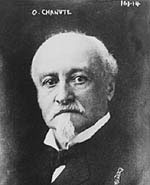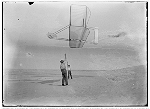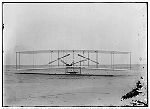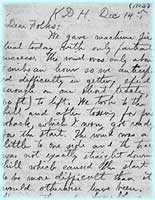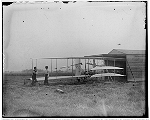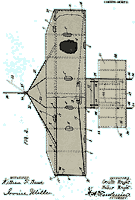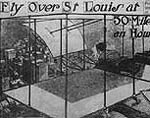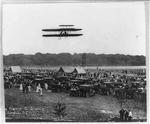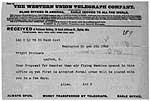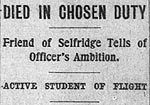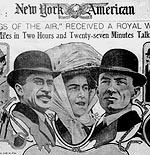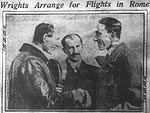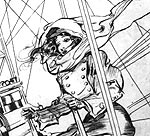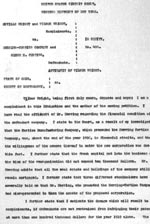1901
June 26
Octave Chanute meets the Wrights for the first time in Dayton.
July
Wilbur's articles, "Angle of Incidence," published in Aeronautical Journal, and "Die Wagerechte Lage Wahrend des Gleitfluges," published in Ilustrierte Aeronautische Mitteilungen, are the brothers' first published aeronautical writings.
July 10
Wrights arrive in Kitty Hawk and begin experiments with a larger glider. From fifty to one hundred flights are made in July and August, ranging in distance from twenty to almost four hundred feet.
August 4-11
Chanute visits the Wrights at Kill Devil Hill and witnesses some of their glider experiments.
August 20
Wrights leave Kitty Hawk.
September 18
Wilbur addresses the Western Society of Engineers on the brothers' 1900-01 gliding experiments.
October -December
Wrights conduct tests on airfoils and build a wind tunnel.
1902
August 28
Wilbur and Orville arrive at their Kitty Hawk camp.
September 8-19
Wrights assemble their new glider.
September 19 -October 24
Wright brothers make between seven hundred and one thousand glides and increase their distance to 622 1/2 feet.
October 28
Wrights leave Kitty Hawk.
December
Wrights conduct experiments with propellers and begin to build their 1903 four-cylinder engine.
1903
March 23
Wright brothers apply for a patent on their flying machine (patent issued May 22, 1906).
September 25
Wilbur and Orville arrive at Kitty Hawk.
September 28 -November 12
Wrights experiment with 1902 glider.
October 9 -November 4
Brothers assemble the 1903 machine and install the engine.
November 5 -December 9
Propeller shafts break twice and brothers return to Dayton to repair them and obtain replacements.
December 14
Wilbur makes the first, but unsuccessful, attempt to fly a powered machine from slope of Big Kill Devil Hill. Machine stalls after 31/2 seconds in the air and lands 105 feet below.
December 17
Wilbur and Orville make the first free, controlled, and sustained flights in a power-driven, heavier-than-air machine. Three men from the Kill Devil Life Saving Station and two from Nags Head witness the four trial flights. First trial is made by Orville at 10:35 A.M., stays twelve seconds in the air, and flies 120 feet. John T. Daniels photographs the first flight with Orville's camera. Wilbur makes the longest flight in the fourth trial, fifty-nine seconds in the air and 852 feet.
December 21
Wrights leave Kitty Hawk.
1904
January 22
Wrights employ Harry A. Toulmin, a patent attorney, to work on their patent case.
March
Wrights apply for French and German patents on their airplane.
April-May
At Huffman Prairie, a large meadow near Dayton, Wilbur and Orville build a new heavier and stronger machine with a more powerful motor.
May-December
Wrights make practice flights with their new 1904 machine at Huffman Prairie–total flying time is forty-nine minutes. Wilbur makes the first turn in the air on September 15 and the first complete circle on September 20. Longest flight of the year is five minutes four seconds, 23/4 miles–almost four circles around the field.
1905
January
U.S. Board of Ordnance and Fortification rejects the Wrights' offer of sale of their airplane.
June
Wright brothers finish work on a 1905 machine and begin making flights in it at Huffman Prairie.
October 5
Wilbur makes the longest flight of the year: 24 1/5 miles in 39 minutes, 23 4/5 seconds, more than twenty-nine times around the field, at an average speed of thirty-eight miles per hour.
October 27
U.S. Board of Ordnance and Fortification declines the Wrights' second offer of their airplane.
1906
January 6
Wrights join the Aero Club of America.
May 22
U.S. Patent Office grants the Wrights patent, No. 821,393, for a flying machine.
1907
Brothers travel to Europe to negotiate for the sale of the Wright airplane abroad. Hart O. Berg and Flint & Company are their agents.
November-December
Wilbur meets with officials from U.S. Signal Corps and Board of Ordnance to discuss their airplane's capabilities.
December 23
U.S. Signal Corps advertises for bids for a military heavier-than-air flying machine to be submitted by February 1.
1908
January 27
Wrights submit their bid to U.S. Signal Corps to supply a heavier-than-air flying machine, weighing between 1,100 and 1,250 pounds, carrying two passengers, and flying at a speed of forty miles per hour.
February 8
Wrights' bid to furnish a flying machine to U.S. War Department for $25,000 is accepted.
April 9
Wilbur and Orville arrive in Kitty Hawk to brush up on their flying skills.
May 14
Wrights carry a passenger on a flight for the first time: Charles W. Furnas flies with Wilbur.
May 29
Wilbur arrives in Paris to demonstrate the capabilities of the Wright airplane in Europe.
August 8
Wilbur makes his first flight at Le Mans, France–the Wrights' first flight in Europe.
August 27
Wright 1908 airplane is assembled and ready for testing at Fort Meyer, Virginia.
September
Orville makes U.S. Army test flights at Fort Meyer and establishes records with and without passengers.
September 17
Orville is seriously injured and his passenger, Lt. Thomas Selfridge, is killed in an airplane crash at Fort Meyer. Airplane crashes to the ground from a height of about seventy-five feet after a propeller blade breaks and the machine goes out of control.
Selfridge is the first airplane fatality.
November 1
Orville and sister Katharine arrive in Dayton after his discharge from the hospital in Fort Meyer.
November 30
La Compagnie Générale de Navigation Aérienne, the French Wright company, organized.
December 31
Wilbur wins 1908 Michelin Cup and a prize of twenty thousand francs with his flight of 123 kilometers, two hundred meters in two hours, 18 minutes, 33 3/5 seconds. He extends this same flight to break a new world record in a time of two hours, 20 minutes, 23 1/5 seconds over 124 kilometers, 700 meters.
1909
January 12
Orville and Katharine join Wilbur in Paris.
January 14
Wilbur arrives at Pau, France. Orville and Katharine join him a few days later.
February -March
Wilbur makes a series of training flights with three French student pilots at Pau.
March 4
Congressional Medal is awarded to the Wrights by resolution of Congress (H.J. Resolution 246), "in recognition of the great service of Orville and Wilbur Wright, of Ohio, rendered the science of aerial navigation in the invention of the Wright aeroplane, and for their ability, courage, and success in navigating the air." Medal is presented to the brothers on June 18.
April 1
Wilbur arrives in Rome to make demonstration flights and train two Italian pilots. Orville and Katharine arrive April 9.
May 11
Wrights arrive in New York.
May 13
Flugmaschine Wright Gesellschaft, the German Wright company in Berlin, is formed.
June
Wrights perform propeller tests in Dayton to determine cause of the Fort Meyer accident in order to prevent similar future accidents.
June 17-18
Two-day celebration thrown by the city of Dayton to honor the Wright brothers.
June 20
Wilbur and Orville arrive in Washington, D.C. to resume trial flights at Fort Meyer for U.S. government.
June 26
Glenn H. Curtiss sells his Curtiss airplane, the first commercial sale of an airplane in the United States, to Aeronautic Society of New York for $7,500. Sale sets in motion the beginning of the Wrights' patent suit against Curtiss.
July 27
With Lt. Frank P. Lahm as his passenger, Orville flies for one hour, 12 minutes, 37 4/5 seconds. Flight fulfills the Army's requirements and is witnessed by President Taft, his cabinet, and other public officials as well as an estimated crowd of ten thousand spectators at Fort Meyer.
August 8
Orville and Katharine leave for Europe for demonstration flights and sales negotiations in Germany.
August 18
Wrights begin a patent suit against Herring-Curtiss Company and Glenn H. Curtiss by filing a bill of complaint to prevent them from manufacturing, selling, or using in exhibition the Curtiss airplane.
August 19
Wrights file suit against Aeronautic Society of New York to prevent further exhibition and use of the Curtiss airplane owned by the society because it infringes on Wright patents.
October 4
As part of the Hudson-Fulton Celebration, Wilbur flies round-trip demonstration flights from Governors Island, New York, to the Statue of Liberty and Grant's Tomb, New York City. More than one million spectators present.
October 8 -November 2
At College Park, Maryland, Wilbur trains first U.S. Army fliers.
November 22
Wright Company, formed to manufacture their airplanes, is incorporated; Wilbur serves as president and Orville as vice president. A few days later, Wrights sell their American patent rights to the company for $100,000, 40 percent of the company stock and a 10 percent royalty for every airplane built.
November-December
Wright Company moves forward on patent lawsuits. Wilbur and Orville give affidavits and attend trial for The Wright Company v. Herring-Curtiss Company and Glenn H. Curtiss patent suit.
1910
January
Wright Company and Wright brothers continue their involvement in patent suits.
March
Wright Exhibition Company formed, with Roy Knabenshue as manager.
March 26-May 5
Orville conducts flight training school in Montgomery, Alabama, for pilots who will fly for Wright Exhibition Company.
June 13-18
Wright Exhibition Company team flies in its first show in Indianapolis, Indiana.
November
Orville travels to Europe to find both the German and French Wright companies struggling financially.
| 
